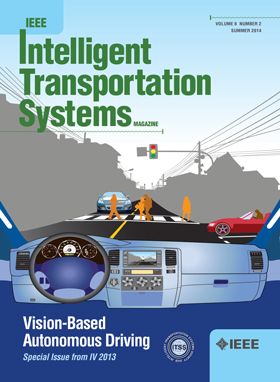多代理移动边缘计算网络中的可持续分布式自适应排兵布阵,以减少车道数量
IF 7.9
1区 工程技术
Q1 ENGINEERING, CIVIL
IEEE Transactions on Intelligent Transportation Systems
Pub Date : 2024-09-18
DOI:10.1109/TITS.2024.3449916
引用次数: 0
摘要
如今,随着通信网络和车辆智能技术的快速发展,车联网自动驾驶汽车(CAVs)已成为下一代智能交通系统(ITS)的强大基础设施。虽然基于排序的技术在 CAV 中前景广阔,但异构交通状况给自组织交通瓶颈中的排序控制带来了挑战,因此迫切需要一种实用的可持续交通架构。为解决这一问题,我们提出了一种软件定义架构,利用多代理技术和移动边缘计算网络实现多车自适应排布,称为 SD-M3ASP。该架构支持对移动车辆和边缘设备之间的车辆边缘通信资源进行集中式和分散式管理,并支持可持续的车辆排队能力。然后,我们提出了基于集群的运动学模型,将车辆分组为多车辆集群(MVC),以促进具有防碰撞功能的高效排队控制。此外,我们还提出了三阶段排控制算法,以自适应地平衡 MVC 的规模,并在异构交通流中形成稳定的排。利用 Routh 稳定性准则和 Lyapunov 技术分析了排内和排间的收敛性。为演示目的开发了 CAV 仿真软件,该软件可在 https://qgailab.com/cav-sim 上在线获取。大量的数值模拟结果表明了所提方法的优越性,它能极大地消除异构交通流引起的自组织拥塞。本文章由计算机程序翻译,如有差异,请以英文原文为准。
Sustainable Distributed Adaptive Platoon in Multi-Agent Mobile-Edge Computing Networks for Lane Reduction Scenario
Nowadays, Connected Automated Vehicles (CAVs) have emerged as powerful infrastructures for the next-generation Intelligent Transportation System (ITS) as the rapid technological advancements of communication networks and vehicular intelligence. While prospective platoon-based techniques in CAVs, the heterogeneous traffic condition poses a challenge for platoon control in the self-organized traffic bottleneck, thus making an urgent need for a practical sustainable transportation architecture. To address this problem, we propose a software defined architecture that leverages multi-agent techniques to mobile-edge computing networks for multi-vehicle adaptive platoon, which is called SD-M3ASP. The architecture supports centralized and decentralized management of vehicular edge communication resources between mobile vehicles and edge devices, and underpins sustainable vehicular platooning capabilities. Then, we propose cluster-based kinematic models by grouping vehicles into multi-vehicle clusters (MVCs) to facilitate efficient platoon control with collision avoidance. Furthermore, we propose three-stage platoon control algorithms to adaptively balance the size of MVCs and form stable platoons in heterogeneous traffic flows. The intra-platoon and inter-platoon convergence are analyzed by using the Routh stability criterion and Lyapunov technique. A CAV simulation software is developed for demonstration purposes which is available online at
https://qgailab.com/cav-sim
. Extensive numerical simulation results have shown the superiority of the proposed method, which can greatly eliminate the self-organized congestion caused by heterogeneous traffic flow.
求助全文
通过发布文献求助,成功后即可免费获取论文全文。
去求助
来源期刊

IEEE Transactions on Intelligent Transportation Systems
工程技术-工程:电子与电气
CiteScore
14.80
自引率
12.90%
发文量
1872
审稿时长
7.5 months
期刊介绍:
The theoretical, experimental and operational aspects of electrical and electronics engineering and information technologies as applied to Intelligent Transportation Systems (ITS). Intelligent Transportation Systems are defined as those systems utilizing synergistic technologies and systems engineering concepts to develop and improve transportation systems of all kinds. The scope of this interdisciplinary activity includes the promotion, consolidation and coordination of ITS technical activities among IEEE entities, and providing a focus for cooperative activities, both internally and externally.
 求助内容:
求助内容: 应助结果提醒方式:
应助结果提醒方式:


